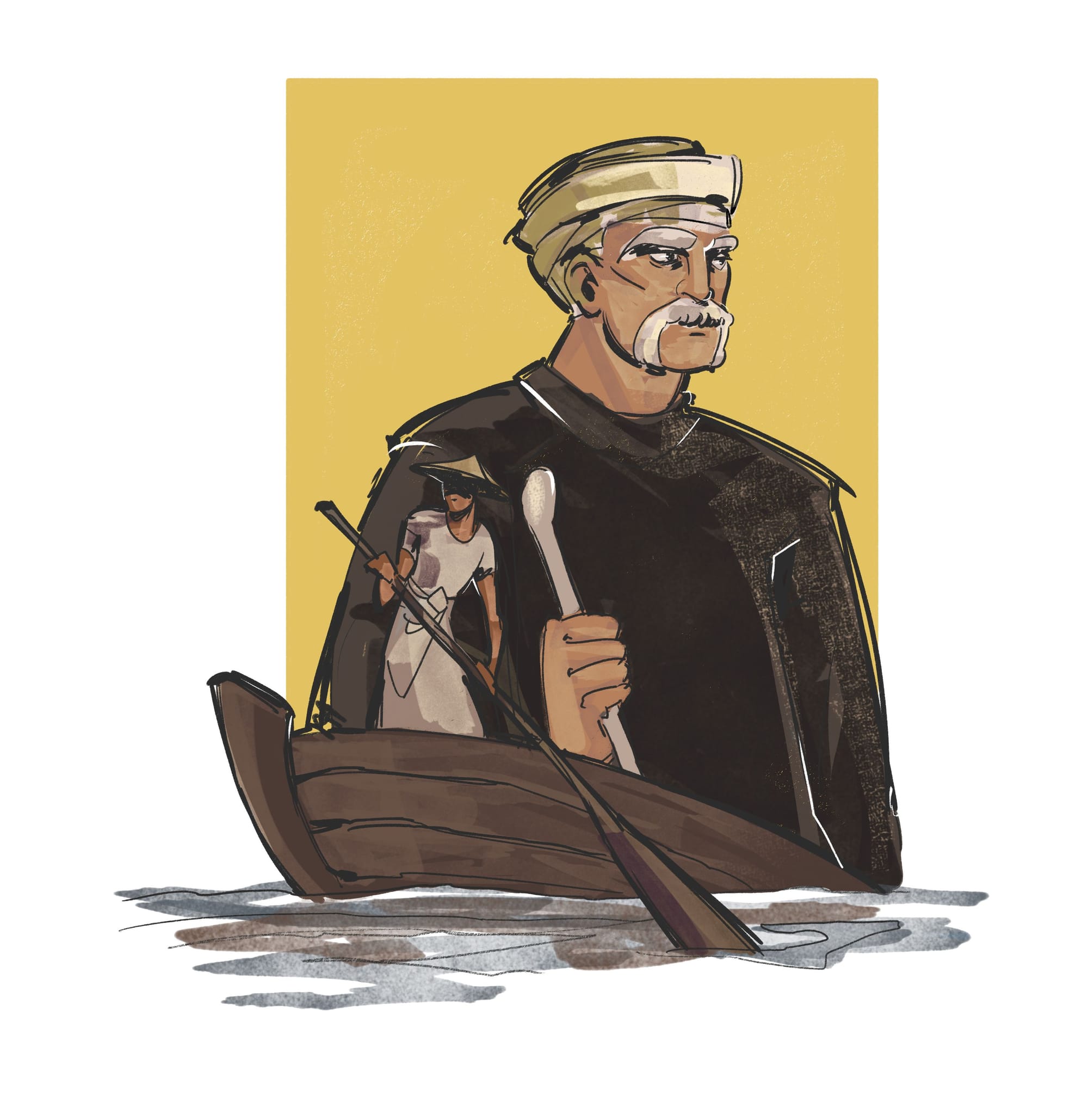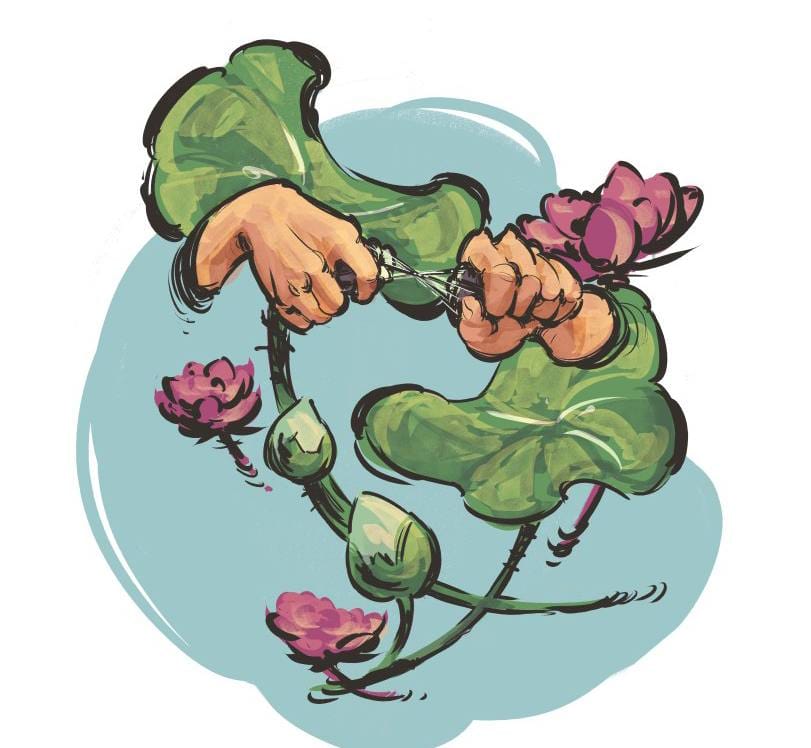
Born in Htauk Kyant, living in Htauk Kyant, she could be called a Htauk Kyant native. In their neighborhood, a pipeline taller than a person has been lying on the ground since the time of their grandparents.
Although Ma Wati has seen the Gyobyu water pipeline since birth, she doesn't know where this large pipe starts and where it ends. Like her, people in her surroundings don't pay special attention to it either.
Water flows from the large pipe. They only noticed that the water has become more turbid recently compared to before. They didn't know when this large pipe was established, who built it, and how important it was.
In fact, this large pipe could be called Yangon's lifeline. It provides water to nearly half of Yangon's population, about 4.5 million people. So, how long has this large pipe been around?
According to Yangon City Development Committee's records, Yangon's water supply began in 1842 from 30 large wells in Yangon. After the Second Anglo-Burmese War, the British government rebuilt Yangon in 1853. They demolished the old fortified city built by Burmese kings and transformed it into a modern city with straight main roads.
As the new city was built, water became crucial. The 30 large wells were no longer sufficient for the city. So, in 1879, they used water from Kandawgyi Lake. In 1884, they took water from Inya Lake. As Yangon gradually developed and became densely populated, the water supply systems had to change accordingly.
In 1900, they began constructing the Hlawga Reservoir to expand Yangon's water supply system. In 1904, they could start supplying water. When building the Hlawga Reservoir, they estimated for a population of about 650,000. However, in reality, it wasn't sufficient to supply adequately.
Therefore, in 1936, they built the Gyobyu Reservoir in Taikkyi Township. It was completed in 1940. At that time's market price, it cost 17.5 million Myanmar Kyats. To supply water from the constructed Gyobyu Reservoir to Yangon city, a pipeline was needed. Thus, they constructed a pipeline from Taikkyi Gyobyu Reservoir to Kokkine Reservoir. Two British engineers designed it, and they used American-made steel pipes. This large pipeline, 56 inches in diameter, nearly 7 feet high, and 43 miles long, is the Gyobyu water pipeline that Ma Wati knows.
The way it was constructed according to the natural terrain is also an interesting aspect of this large pipeline. Water naturally flows from high to low due to Earth's gravity. The British experts made the water from Gyobyu Reservoir flow into Kokkine Reservoir naturally, without the need for electric motors or water pumps, following Earth's gravity. From Kokkine Reservoir, water is supplied to Yangon's Downtown Area.
After 1990, as Yangon became densely populated and townships along the pipeline started tapping water from it, water didn't reach the downtown area sufficiently. So, the natural flow system disappeared, and they had to use water pumps.
Not everyone gets Gyobyu water for free. You need to apply for usage permission at YCDC. If approved, you can use it by paying a monthly water fee. So, just living near the large pipe doesn't mean you have permission to use Gyobyu water. Actually, besides Gyobyu, there are four other water sources supplying Yangon, but Yangon people call all YCDC water "Gyobyu water" based on this large pipe.
The lifespan of this Gyobyu pipeline stretching from Taikkyi to Kokkine Reservoir is now over 80 years. Records say it has never broken or been damaged. As far as Ma Wati remembers, this large pipe has never been damaged.
The large pipe withstood bomb damage during World War II. During internal insurgencies, it was attacked with mines no less than four times. The last impact, which could be called damage, was the magnitude 5.8 Taikkyi earthquake in 2017, but it wasn't damaged. Ma Wati thinks this might be due to the quality of the large pipe or perhaps because the conditions for its destruction haven't aligned yet.
"We've been playing on this since we were young. We climb up and down the pipe. We walk on it. We cross from one side to the other. Because we always see it, we don't think it's strange. We didn't know its value either. Now I'm becoming interested. It has value, you know."
Historically valuable like an antique, this large pipe is still directly related to social lives. This 43-mile long large pipe lies like a giant snake in the suburban neighborhoods it passes through, from Gyobyu Reservoir in Taikkyi to Kokkine Reservoir
That's why the large pipe plays an important role in the daily lives of people like Ma Wati who live near the pipeline. Among those living along the pipeline, some use the large pipe's water, while others don't. Whether they use it or not, everyone has benefited from the atmosphere the large pipe provides.
They use the large pipe as a pedestrian path. In some places, bridges are built over the pipe to make it easier to travel. Young people sit on the large pipe and play guitar. In the evenings, you can find people sitting on the large pipe chatting and people playing chinlone beside it. For some couples, the large pipe becomes a meeting point.
There are also people who make gardens beside the pipe. The gardens have everything from fruit trees to flowers. You can also find small shops like tea shops and beer shops beside the large pipe. For children, the large pipe is a playground.
This habit isn't unique to Ma Wati's neighborhood. It's like a culture that exists among all people living along the large pipe. For those squatting on the pipeline's land, their connection with the pipe is even stronger.
"At first, I thought only we did this. But it's not true. Everyone living beside the pipe has these habits. I don't know if we should call it pipeline culture," says Ma Wati.
Walking on the over 80-year-old large pipe might be normal for people like Ma Wati, but not everyone has done it. The person who saw this gap was Jochen Meissner, who founded Uncharted Horizons Myanmar travel business.
During the global COVID-19 pandemic in 2019, people had to stay at home for months without going out. In the post-COVID era, everyone wanted to reconnect with nature, get fresh air, and seek new adventures. So, someone in Jochen Meissner's team had the idea to walk on the large pipe. Actually, they didn't know where the large pipe started and where it ended either. So, they decided to walk on the large pipe and see.
Their journey walking on the Gyobyu large pipe unexpectedly became an interesting trip. While walking on the large pipe, they got to study the residential neighborhoods and social environments beside the large pipe. During the walk, they encountered exciting challenges like water fountains from water control pipe heads in some places, bridges crossing over the pipe, and crossing large drains a few meters deep.
With that, they planned a walking tour on the pipe.
They firmly believed that for tourists visiting Yangon, walking on the Gyobyu pipeline would provide a unique experience and feeling compared to regular places like Shwedagon Pagoda, Sule Pagoda, People's Square, and Bogyoke Market. The trip intended for international tourists unexpectedly attracted domestic tourists as well.
Thus, the large pipe that no one had been interested in before suddenly became famous. The history and age of the large pipe also became an attraction. It received good feedback from travelers as an interesting trip. This was also surprising for Ma Wati.
"I never thought walking on the pipe would become a travel program. I really didn't know you could make money from something like this. It's good, the idea. Even I want to try walking like them."
2019 could even be called the year of the Gyobyu large pipe. That's because, like Jochen Meissner, another person interested in the large pipe emerged.
He is French architect Raphael Monnier from Blue Temple, a Yangon-based architecture company. He had lived near the large pipe. So, he noticed the interaction between the large pipe and social lives. His idea wasn't a travel program, but he wanted the large pipe to become a public recreation area. Because there aren't many green and public recreational parks in Yangon, he aimed to make the large pipe a public recreation area. In other words, he wanted to transform the large pipe into a new form.
So, he started a project related to the large pipe in 2019. His project was to plant shade trees along the Gyobyu large pipe and construct recreational garden designs mainly using bamboo.
To implement this project, they held workshops with architecture students from Yangon Technological University, Mandalay Technological University, West Yangon Technological University, and STI Myanmar University. Designs were drawn from these workshops to create shaded areas along the pipeline and create places for children to play. Two Hong Kong-based architecture companies and some NGOs from Yangon also collaborated for this.
Because of this project, people became more interested in the large pipe. There were also discussions about the health of the large pipe in parliament. Due to increased population density and waste disposal near the large pipe, there were repairs for reduced oxygen reaching the large pipe and rust forming at the base of the pipe.
This project was news for people like Ma Wati who live near the large pipe. Ma Wati had never thought that the large pipe could become a recreational area.
"When I heard about that project, I was interested. I never thought something like this could be done. I even felt a bit proud that the large pipe could generate such interest. It made me realize we should take care of this large pipe. If the project and travel program succeed, it might create new opportunities for us living near the pipe. You never know."
But it didn't turn out as Ma Wati hoped. The large pipe's travel program and recreational project came to a halt after the 2021 coup due to the political situation. Amidst the country's conditions, the pipeline culture also had to change.
The large pipe can no longer provide the same security as before. Evenings are no longer as lively as before. Young people who used to come play guitar near the large pipe have left for various reasons to other places. People who used to use the large pipe as a pedestrian path no longer dare to cross it when darkness falls.
Although Ma Wati feels sad for the large pipe that no longer has the same atmosphere as before, she herself is not yet free from the constraints of the times.
"Even I don't go for walks near the pipe anymore. We keep hearing about bombs near the pipe, whether it's true or not. Parents don't let their children go that way much anymore. It's nothing specific. We just started to feel it's not safe."
Now, the Gyobyu large pipe lies peacefully as it has for over 88 years. The large pipe not only doesn't experience new atmospheres but has also lost its usual regular vitality. However, as it has served without fail for over 88 years, it still continues to deliver water for the people of Yangon.
Ma Wati can no longer predict what the future holds for the Gyobyu water pipeline that lies on the ground, serving for the benefit of Yangon's people, just as the pipeline itself doesn't know.
Nay Thit Moe ( Y3A )
Read More:
 Build Myanmar - MediaY3A
Build Myanmar - MediaY3A
 Build Myanmar - MediaY3A
Build Myanmar - MediaY3A
Build Myanmar-Media : Insights | Empowering Myanmar Youth, Culture, and Innovation
Build Myanmar-Media Insights brings you in-depth articles that cover the intersection of Myanmar’s rich culture, youth empowerment, and the latest developments in technology and business.
Sign up for Build Myanmar - Media
Myanmar's leading Media Brand focusing on rebuilding Myanmar. We cover emerging tech, youth development and market insights.
No spam. Unsubscribe anytime.
Sign up now to get the latest insights directly to your mailbox from the Myanmar's No.1 Tech and Business media source.
📅 New content every week, featuring stories that connect Myanmar’s heritage with its future.
📰 Explore more:
- Website: https://www.buildmyanmarmedia.com/
- Facebook: https://www.facebook.com/buildmyanmar
- YouTube: https://youtube.com/@buildmyanmarmedia
- Telegram: https://t.me/+6_0G6CLwrwMwZTIx
- Inquiry: info@buildmyanmar.org
#BuildMyanmarNews #DailyNewsMyanmar #MyanmarUpdates #MyanmarNews #BuildMyanmarMedia #MyanmarNews #GlobalNews #TechNewsMyanmar #BusinessNewsMyanmar #Updates #Insights #Media
